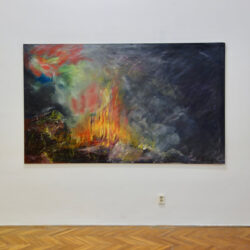The show is part of our series entitled The Fall of the Wall, which is a twin-exhibition selected by Hans Knoll in Vienna. The works of several artists (Imre Bak, László Fehér, László Mulasics, Tamás Soós) are featured in both presentations and pieces from one series (Károly Halász) appear at both locations.
The art documents of an Austrian collector and his colleague´s activities, dedicated to Hungarian painting, are considered worthy of presentation for an Austrian-Hungarian gallery: both exhibitions were selected from the material of the Pedit collection. “Filtering” is multiple: by the limited space and time available for building a collection, purchasing artworks and connecting to the related exhibitions.
Gaudens Pedit, a young Austrian businessman during his studio visits in the early 1980s and 1990s – with the help of Johann van Damm and then Loránd Hegyi – focused mainly – but not exclusively – on the works that represent New Sensibility. The trend was then – still in the mid-1980s, beyond its peak exhibitions – a decade-long story. The period of the regime change put its already controversial reception in multiple refractions.
Coming from the west across the border, the unified and concentrated, unexpected and most importantly – with the European phenomena of similar characteristics – the simultaneous appearance is already partly appreciated as a sign of the change of regime. This is confirmed by showing up at state exhibitions as well. The power of the “surprise factor”, the richness and variety of the artwork in the block at major international exhibitions, due to the curatorial work behind it and the intellectual performance of the program building, it is still present and makes an impact, despite the characteristic changes in the trend.
The overall image of the two exhibitions is “radically eclectic” – due to the period of collecting (1988-1994), the framework defined by the works (1979-1992) and the focus. The paintings (compared to the rich material of the former Pedit collection, which presents individual oeuvres in a broader intersection) are implying of the changes in the direction of individual careers leading from the “core period” of the New Sensibility (the work of El Kazovsky in Vienna and Zoltán Tölg-Molnár in Budapest are exceptions).
But even within the narrow frames of the Budapest exhibition, there seems to be a shift – never giving up the sensual element – in the use of color and form, in the treatment of materials and surfaces, from large-format, from the generous expressiveness to the direction of meditative and / or playful-ironic post-geometry.
From point of view in Vienna (recalling the Austrian and Italian pieces in the collection) – the still coveted Central European cultural identity that regularly proves to be a mirage in front of the spiritual background of the monarchy’s distant memory – it may even raise the possibility of a regional reading of the new painting movement, but from the perspective of Budapest it seems to be more of an inclusion, an unspoken story.
Mostly from the aspect of comprehensive analyzes about the segments of art history, since the images themselves, as an integral part of oeuvres are often discussed as elements of overlapping eras: turning points, catalysts of internal inspirational movements.
However, the endpoints and transitions of the ’80s – which are in between the ’70s and controversial beginnings of the regime change – are still unclear in many ways. The current constellation of images is a snapshot of a temporary state, a fund saving and recollection of the past. Reconstruction of an external / adjacent look that is able to raise valid questions even in this fragmentary form.
László Százados
